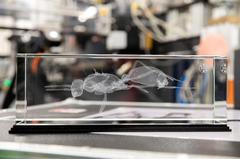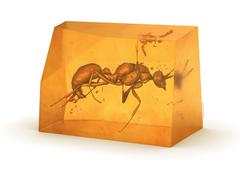URL: https://www.desy.de/news/news_search/index_eng.html
Breadcrumb Navigation
DESY News: New ant genus named after DESY
News
News from the DESY research centre
New ant genus named after DESY
An international team of scientists led by Friedrich Schiller University Jena has identified a previously unknown extinct ant in a unique piece of African amber about 20 million years old. The team used DESY's X-ray light source PETRA III to examine the critical fossil remains from 13 individual animals at a specialised measuring station operated by Helmholtz-Zentrum Hereon and realised that these could not be attributed to any known species. The new species even establishes a completely new genus of primordial ants, as the scientists from the Universities of Jena, Rennes (France) and Gdansk (Poland) as well as from Hereon report in the scientific journal Insects. The new genus was named after DESY, the new species after Hereon: With the scientific name †Desyopone hereon gen. et sp. nov., the discoverers honour the two research institutions, which had contributed significantly to this discovery with modern imaging methods.

Martin Müller, director of the Institute for Materials Physics at Helmholtz-Zentrum Hereon, and Christian Schroer, Leading Scientist of DESY's X-ray source PETRA III, accept a model of the newly identified ant from Brendon Boudinot, lead author of the paper from Friedrich Schiller University Jena, and co-author Jörg Hammel, beamline scientist at the Hereon measurement station at PETRA III, where the research took place (from left to right). Credit: DESY, Marta Mayer
Initial anatomical comparisons led the scientists to assume that the animals were a species of Aneuretinae, an almost extinct subfamily of ants known so far only through fossils and a single living species from Sri Lanka. But they revised this identification thanks to the high-resolution 3D X-ray images obtained at the Hereon-operated beamline P05 of PETRA III.
“The complex waist segment and the large but rudimentary mandibles – the mouthparts – are more familiar to us from the Ponerinae, a dominant group of predatory ants,” says main author Brendon Boudinot, who is currently working at the University of Jena on a Humboldt Research Fellowship. “For this reason, we’ve assigned the new species and genus to this subfamily, even though it has a unique appearance, as the long waist and otherwise unconstricted abdomen are more reminiscent of the Aneuretinae.”
Dating the find also presented the scientists with some challenges, as the amber recovered in Ethiopia itself is as unique as the organisms inside it. “The piece with these ants is from the only amber deposit in Africa so far that has fossil organisms in inclusions. Altogether, there are only a few fossil insects from this continent,” explains co-author Vincent Perrichot from the University of Rennes. “Although amber has long been used as jewellery by locals in the region, its scientific significance has only become clear to researchers in the last 10 years or so. The specimen therefore offers what is currently a unique insight into an ancient forest ecosystem in Africa.” It dates from the early Miocene and is 16 to 23 million years old, says Perrichot. Its complicated dating was only possible indirectly, by determining the age of the fossil palynomorphs – the spores and pollen – enclosed in the amber.

Magnified representation of the extinct ant in a glass block in the Hereon measuring station at DESY's X-ray light source PETRA III, where the original had been studied. Credit: DESY, Marta Mayer
“Since the ants enclosed in amber are very small and only show a very weak contrast in classical CT, we carried out the CT at our measuring station that is specialised in micro tomography,” explains co-author Jörg Hammel from Hereon. “This provided the researchers with a stack of images that basically showed the sample that was being studied slice by slice.”
Put together, these produced detailed three-dimensional images of the internal structure of the animals, which the researchers could use to reconstruct the anatomy with precision. This was the only way to precisely identify the details that ultimately led to the new species and genus being determined.
According to current knowledge, ants have been around for about 140 million years. To date, about 14 000 living and 763 extinct ant species have been described. They belong to about 350 living and 167 extinct genera. Desyopone hereon is so far the only species of the new (168.) extinct genus. However, it would be plausible that some still existing species of the new genus Desyopone could one day be discovered somewhere in Africa, the researchers write. There is a corresponding example from a South American ant genus that was believed to be extinct but was later discovered alive. „Desyopone may still be out there,“ says Boudinot.

Illustration: Hereon, Jörg Hammel/Jonas Lauströer
Reference:
Genomic-phenomic reciprocal illumination: †Desyopone hereon gen. et sp. nov., an exceptional aneuretine-like fossil ant from Ethiopian amber (Hymenoptera: Formicidae: Ponerinae); Brendon E. Boudinot, Adrian K. Richter, Jörg U. Hammel, Jacek Szwedo, Błażej Bojarski, Vincent Perrichot; „Insects“, 2022; DOI: 10.3390/insects13090796
Further reading:
- Press release by Friedrich Schiller University Jena
- Press release by Helmholtz-Zentrum Hereon



